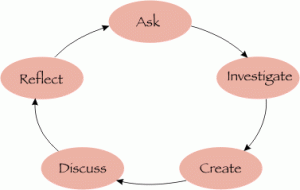(This is cross-posted from Smart and Good.)
I am breathing slowly and deeply this morning, puzzled and saddened by something I heard yesterday on NPR. The Smithsonian’s National Portrait Gallery pulled part of the art exhibition “Hide and Seek” on Thursday under pressure from, among others, the Catholic League. Removed from view was a 4 minute video exploring death by AIDS and depicting Jesus on the cross being eaten by large black ants. However, my concern here is not the piece, nor the protest nor even the pronouncement that the Smithsonian would remove David Wojnarowicz‘s representation of his lover’s death, “A Fire in My Belly.”
Others have had interesting things to say on both sides of this issue if you want to pursue it:
http://riskrapper.wordpress.com/2010/12/02/
http://www.cnsnews.com/news/article/smithsonian-christmas-season-exhibit-fea)
I am most distressed today as an American educator by the post-game comments of Bill Donovan, the President of the Catholic League. Donovan, reveling in his triumph, is now working to undercut any and all taxpayer supported arts in the United States. What would this do to educational possibility in our present cultural and economic position? What do we lose if we fail to support the images and ideas that stretch us?
Donovan’s case goes something like this. Because there is no taxpayer support for that which “working people” appreciate, specifically the World Wrestling Federation, then there should be no taxpayer support for any other kinds of arts and entertainment. Hmmmm.
[Sidenote here: The government of Abu Dhabi has initiated a revitalization of their economy by importing branches of the Guggenheim and the Louvre – a decidedly different take on what impacts a people toward productivity.]
Now there’s a lot of art I don’t understand and a lot I don’t appreciate (including WWF), but even the stuff I don’t understand (sometimes especially that stuff) stretches me (including WWF). And that stretching is part of my ongoing education. Because WWF is widely supported by both people who work and people who don’t, it is available to me. I can be – and very occasionally am – stretched by it. But other arts not commercially viable are nonetheless valuable. Sometimes that which we most need to enhance our collective sensibilities, to expand our abilities to respond to each other with understanding and appreciation, is that which we avoid, resisting enhancement or expansion, because it is uncomfortable. We don’t want to be stretched.
WWF may be one way of exploring the human condition, but it is not the only way. The visual and performing arts have this exploration as their raison d’etre. Videos like “A Fire in my Belly “ are such an exploration, an invitation to feel, to think, to act with integrity in the world.
Now here’s the part that’s tricky. That which is shocking can either prompt or impede educational stretching. Shock is, by definition, experience marked by strong feelings. Such feelings can open us up to educational possibility, but they can also harden into fear (flight, fight and/or paralysis) before reason or reflection can connect those feelings to possibilities for new understanding or action. Mr. Donovan is afraid. Something has scared him. It’s not this particular video (a Christian who has pondered “The Passion of the Christ” has already dealt with images more shocking than these), but there is something that has prompted the members of the Catholic League to flee deeper understanding, to fight those who seek it for themselves, to freeze in the track of past experience rather than renewed possibility. As an educator, I have to name this as fear and resist it – and resist as well any effort to shrink the artistic world or narrow the aesthetic sensibility that is available to me.
Government-supported funding of the arts serves precisely this purpose: to keep in play just those representations and explorations of that human (American) experience that we do not necessarily seek out, that we don’t readily pay to support. It is never time to cut the budget for what educates all of us.

